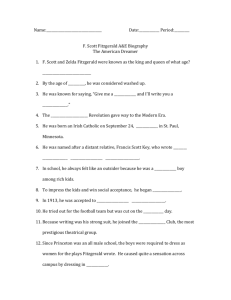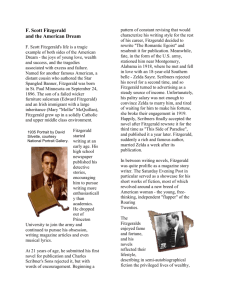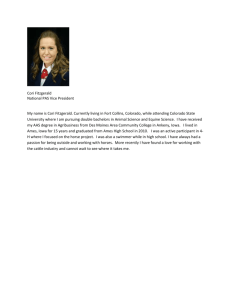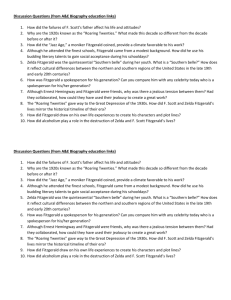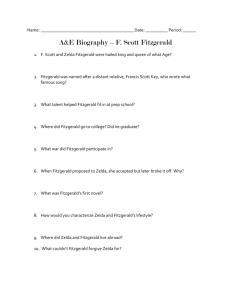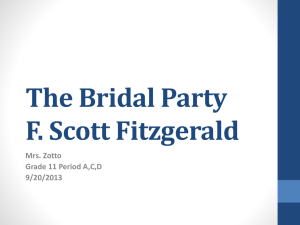The 1920`s, also known as the Jazz Age, were wild times, and
advertisement
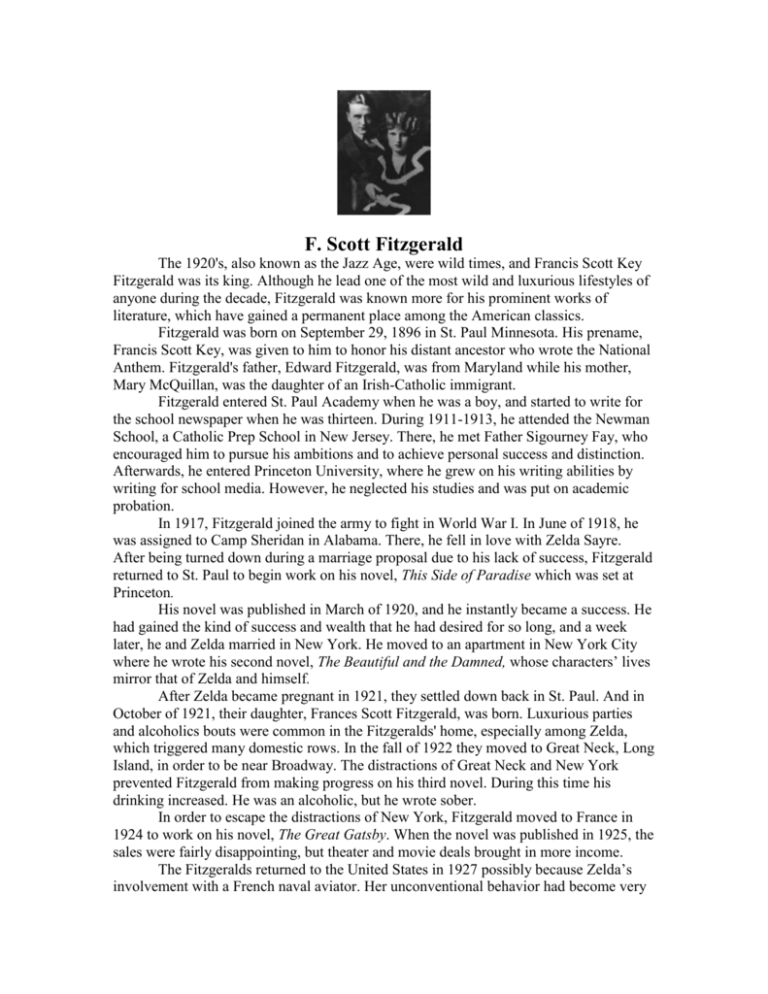
F. Scott Fitzgerald The 1920's, also known as the Jazz Age, were wild times, and Francis Scott Key Fitzgerald was its king. Although he lead one of the most wild and luxurious lifestyles of anyone during the decade, Fitzgerald was known more for his prominent works of literature, which have gained a permanent place among the American classics. Fitzgerald was born on September 29, 1896 in St. Paul Minnesota. His prename, Francis Scott Key, was given to him to honor his distant ancestor who wrote the National Anthem. Fitzgerald's father, Edward Fitzgerald, was from Maryland while his mother, Mary McQuillan, was the daughter of an Irish-Catholic immigrant. Fitzgerald entered St. Paul Academy when he was a boy, and started to write for the school newspaper when he was thirteen. During 1911-1913, he attended the Newman School, a Catholic Prep School in New Jersey. There, he met Father Sigourney Fay, who encouraged him to pursue his ambitions and to achieve personal success and distinction. Afterwards, he entered Princeton University, where he grew on his writing abilities by writing for school media. However, he neglected his studies and was put on academic probation. In 1917, Fitzgerald joined the army to fight in World War I. In June of 1918, he was assigned to Camp Sheridan in Alabama. There, he fell in love with Zelda Sayre. After being turned down during a marriage proposal due to his lack of success, Fitzgerald returned to St. Paul to begin work on his novel, This Side of Paradise which was set at Princeton. His novel was published in March of 1920, and he instantly became a success. He had gained the kind of success and wealth that he had desired for so long, and a week later, he and Zelda married in New York. He moved to an apartment in New York City where he wrote his second novel, The Beautiful and the Damned, whose characters’ lives mirror that of Zelda and himself. After Zelda became pregnant in 1921, they settled down back in St. Paul. And in October of 1921, their daughter, Frances Scott Fitzgerald, was born. Luxurious parties and alcoholics bouts were common in the Fitzgeralds' home, especially among Zelda, which triggered many domestic rows. In the fall of 1922 they moved to Great Neck, Long Island, in order to be near Broadway. The distractions of Great Neck and New York prevented Fitzgerald from making progress on his third novel. During this time his drinking increased. He was an alcoholic, but he wrote sober. In order to escape the distractions of New York, Fitzgerald moved to France in 1924 to work on his novel, The Great Gatsby. When the novel was published in 1925, the sales were fairly disappointing, but theater and movie deals brought in more income. The Fitzgeralds returned to the United States in 1927 possibly because Zelda’s involvement with a French naval aviator. Her unconventional behavior had become very eccentric. During 1930, Zelda's physical and mental condition had deteriorated to the point where she suffered a mental breakdown in April of 1930. She entered the Prangins clinic to receive psychiatric treatment for her mental illness. As a result, Fitzgerald had to suspend his novel writing to write short stories to pay for her costly treatment. Zelda Fitzgerald suffered a relapse in February 1932 and entered Johns Hopkins Hospital in Baltimore. She spent the rest of her life as a resident or outpatient of sanitariums. In 1934, Fitzgerald's final attempt at a hit novel, Tender Is the Night, was published in hopes that he could earn enough for Zelda and his daughter. The ambitious novel was a commercial failure. Set in France during the 1920s, Tender Is the Night examines the deterioration of Dick Diver, a brilliant American psychiatrist, during the course of his marriage to a wealthy mental patient. However, like The Great Gatsby, its sales were disappointing. And by 1936, Fitzgerald was ill, drunk, and in debt. So he headed off to Hollywood in 1937 hoping to become a prominent screenplay writer. However, the only screen credit he received was for the film, Three Comrades. After failing in Hollywood, Fitzgerald fell in love with the young columnist, Sheilah Graham. After MGM dropped his options in 1938, Fitzgerald returned to novel writing. He had worked on The Love of the Last Tycoon, but Fitzgerald died from an unfortunate heart attack in Sheilah's apartment on December 21, 1940. Zelda Fitzgerald perished at a fire in Highland Hospital in 1948. F. Scott Fitzgerald died believing himself a failure. The obituaries were condescending, and he seemed destined for literary obscurity. But then during the late 1940's, a revival of Fitzgerald's works made both him and his works more appreciated. By 1960 he had achieved a secure place among America’s enduring writers. Presently, The Great Gatsby, a work that seriously examines the theme of aspiration in an American setting, defines the classic American novel. Answer the questions on a separate sheet of paper: 1. Who is Fitzgerald named after? 2. Why does Zelda break of their engagement? When does she marry him? 3. Name the various places Fitzgerald lived. 4. How was The Great Gatsby received when it was published and how is it viewed now? 5. What are some of Fitzgerald’s vices? 6. Why does Fitzgerald take a break writing his novel, Tender is the Night? 7. Based on the information given, do you think that their daughter, “Scottie” played a significant role in their lives or marriage? Support your reasoning. 8. Why do you think Fitzgerald never divorced Zelda, even though he later fell in love with Sheilah? 9. What are the names of Fitzgerald’s novels, and if given, what are they about? Are they autobiographical in any way? 10. How did Fitzgerald view himself when he died? Why do you think he felt this way? 11. How did the public treat his death? How was it different from today? Matthew J. Bruccoli’s “A Brief Life of Fitzgerald” originally appeared in F. Scott Fitzgerald: A Life in Letters, ed. Bruccoli with the assistance of Judith S. Baughman (New York: Scribners, 1994.); essay reprinted courtesy of Simon & Schuster.

